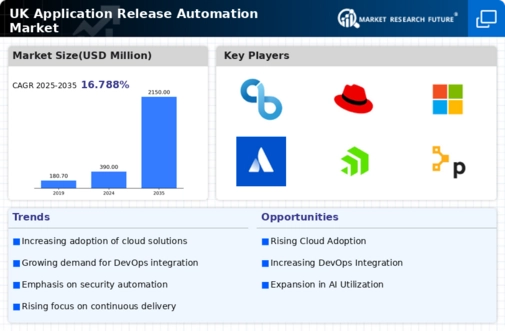The application release-automation market is currently characterized by a dynamic competitive landscape, driven by the increasing demand for faster and more efficient software delivery processes. Key players such as Microsoft (US), IBM (US), and Atlassian (AU) are strategically positioning themselves through innovation and partnerships. Microsoft (US) focuses on integrating its Azure DevOps services with advanced AI capabilities, enhancing automation and streamlining workflows. IBM (US) emphasizes its hybrid cloud solutions, which facilitate seamless application deployment across various environments, thereby appealing to enterprises seeking flexibility. Atlassian (AU) continues to enhance its collaboration tools, fostering a community-driven approach that encourages user feedback and iterative development, which collectively shapes a competitive environment that prioritizes agility and responsiveness.
In terms of business tactics, companies are increasingly localizing their operations to better serve regional markets, optimizing supply chains to reduce costs and improve delivery times. The market appears moderately fragmented, with a mix of established players and emerging startups vying for market share. This competitive structure allows for diverse offerings, yet the influence of major players remains significant, as they set industry standards and drive technological advancements.
In October 2025, Microsoft (US) announced the launch of a new AI-driven feature within its Azure DevOps platform, aimed at automating code reviews and enhancing developer productivity. This strategic move is likely to solidify Microsoft's position as a leader in the application release-automation space, as it addresses the growing need for efficiency in software development processes. The integration of AI not only streamlines operations but also positions Microsoft to leverage data analytics for continuous improvement.
In September 2025, IBM (US) unveiled a partnership with a leading cloud provider to enhance its application release-automation capabilities. This collaboration is expected to expand IBM's reach in the hybrid cloud market, allowing clients to deploy applications more effectively across multiple environments. The strategic importance of this partnership lies in its potential to attract enterprises looking for comprehensive solutions that combine automation with cloud flexibility, thereby enhancing IBM's competitive edge.
In August 2025, Atlassian (AU) launched a new initiative aimed at integrating its tools with popular open-source platforms, fostering a more inclusive ecosystem for developers. This strategic action reflects Atlassian's commitment to community engagement and innovation, as it seeks to enhance user experience and drive adoption of its products. By aligning with open-source projects, Atlassian may also tap into a broader user base, further solidifying its market presence.
As of November 2025, the competitive trends in the application release-automation market are increasingly defined by digitalization, sustainability, and AI integration. Strategic alliances are playing a crucial role in shaping the landscape, as companies collaborate to enhance their technological capabilities and market reach. Looking ahead, competitive differentiation is likely to evolve from traditional price-based competition to a focus on innovation, technology, and supply chain reliability, as organizations seek to deliver value through enhanced automation and efficiency.





















Leave a Comment